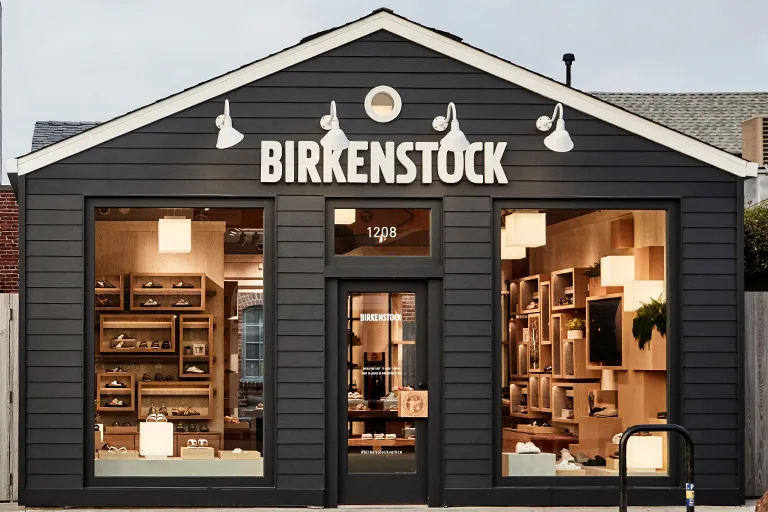Table of Contents
Introduction
On 13th September, Birkenstock filed for IPO . The IPO is anticipated to have a $8 billion valuation. In 2022, Birkenstock recorded revenue of around $1.3 billion, an 18% increase from the previous year.
For the uninitiated, Birkenstock is a German footwear company that was founded way back in 1774. It has a rich history, and it's now poised to take its next big step by going public on the stock market.
If you are still not able to figure out. Margot Robbie's character, Barbie, wore a pair of pink Birkenstocks.
In case you forgot (or missed the moment after wiping away tears), in the final scene, Barbie takes her first trip to the gynecologist, a milestone occasion for anyone. To do so, she wears a white tank tucked into jeans and toped it off with a khaki blazer. The camera then pans to her feet, which lay comfortably flat in her own pair Birkenstocks. In powder pink, of course. - Source Bustle.com
It was a great product placement moment for the brand and really captured the playful and carefree spirit of Barbie. It was also a testament to the versatility of Birkenstocks - they can be both fashionable and functional.

Who Owns Birkenstock
Birkenstock was founded in 1774 and its family members step down from the company around 10 years ago. In 2021, L Catterton acquired the majority of Birkenstock; the transaction valued the business at around $4.3 billion.
LVMH, owned by billionaire Bernard Arnault and home to 75 fashion and cosmetics brands, is a backer of L Catterton. LVMH was the first corporation in Europe to be valued at $500 billion. Arnault is the second wealthiest person in the world, after Tesla CEO Elon Musk, with a net worth of $195.2 billion.
What is the History of Birkenstock
Deep in the small village of Langen-Bergheim, nestled in the rolling hills of Hessian Germany, Johann Adam Birkenstock was officially recorded as a shoemaker in 1774. Little did he know that his humble beginnings would be the foundation of one of the world's most iconic footwear brands.
At that time, the average person would own one pair of shoes their entire life, which would be repaired over the years by a local cobbler. Among poorer communities, shoes would even be handed down from generation to generation. It’s no surprise, then, that people formed a close bond with their footwear. (Source- Company website)
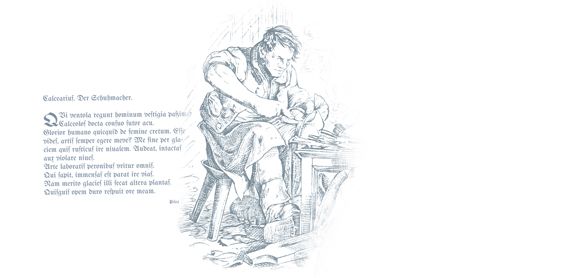
The dawn of the 20th century brought with it a wave of industrialization and modernization to Germany. Traditional shoemakers found themselves threatened by the rise of mass-produced shoes in factories. Many had to change their profession to cobblers, repairing the footwear made by machines rather than creating it themselves.
Konrad Birkenstock, the great-grandson of Johann Adam Birkenstock, led the family's business to new heights. In 1895, Konrad moved the company to Frankfurt, a city that would be the perfect base for the business to grow and thrive.
Konrad Birkenstock, knew he had to adapt to the shifting tide of the shoe industry. So, in 1896, he began manufacturing and selling flexible footbed insoles, giving lectures to cobblers and guilds about his new concept.
Over the course of 15 years, Konrad Birkenstock traveled across Germany and Austria, giving lectures to master cobblers and guilds to explain his vision of fully malleable, custom-made shoes. In addition, he sold licenses that allowed others to manufacture his innovative footbed shoe design, adapting to the changing market and expanding his reach.
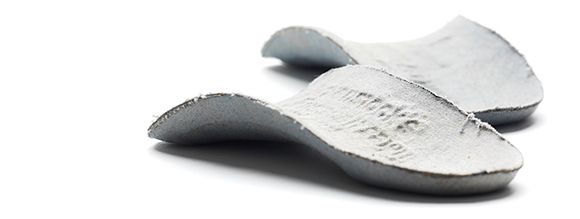
In 1925, in order to meet the growing demand for his innovative footbed shoe design, Konrad Birkenstock expanded his factory to operate around the clock. A few years later, Carl Birkenstock launched the 'Blue footbed' and introduced 'System Birkenstock,' a unique combination of handcrafted shoes made with orthopedic lasts and featuring flexible footbeds.
This was very unique approach to increase the acceptability of products in shops and customers.
Books published
- In 1947, Podiatry – The Carl Birkenstock System is published with a print run of 14,000 copies
- In 1972, The Book of Foot Care by Karl Birkenstock is published with a print run of 30,000 copies.
- In 1983, The BIRKENSTOCK Foot Primer by Karl Birkenstock is published with a print run of 360,000 copies.
In 1966, Margot Fraser, a German dressmaker living in California, was traveling to her native country in order to visit a spa in Bavaria. There, she was advised to try Madrids to treat a foot condition brought on by wearing tight shoes. Birkenstocks were first made available in the United States as a result of Fraser's enthusiasm for the sandals and alleviation from her foot ailment.
In 2013, BIRKENSTOCK becomes a corporation. The traditional company successfully makes the transition from a loose network of 38 separate companies to a group with three business units (productions, sales, services). The group is led by an executive team, which for the first time is not composed of family members.
In 2021, L Catterton acquired the majority stake in Birkenstock.
What Diffferentiates Birkenstock - "Naturgewolltes Gehen"
The Company is guided by a simple, yet fundamental insight: human beings are intended to walk barefoot on natural, yielding ground, a concept it refer to as “Naturgewolltes Gehen.”
Preserving Naturgewolltes Gehen is the fundamental funcitional concept of Birkenstock
Every foot employs 26 bones, 33 muscles and over 100 tendons and ligaments in walking. Improper footwear can cause friction, pain, injury and poor posture, among other ailments. Our anatomically shaped BIRKENSTOCK footbed provides natural support and stimulation, promoting even weight distribution, fully supported arches and no unnatural pressure points from heel to toe. Orthopedic theory suggests the benefits of walking barefoot on natural yielding ground are far reaching, including pain reduction in the foot and throughout the body, improved mobility, and natural posture, since the foot is kept in its natural state. By mimicking the effects of natural yielding ground (“footprint in the sand”), the “System Birkenstock” leans on the benefits of this phenomenon, attempting to enable walking as intended by nature. The inherent functionality of our products enables BIRKENSTOCK to serve a distinct purpose for consumers. - Birkenstock F-1 Filing
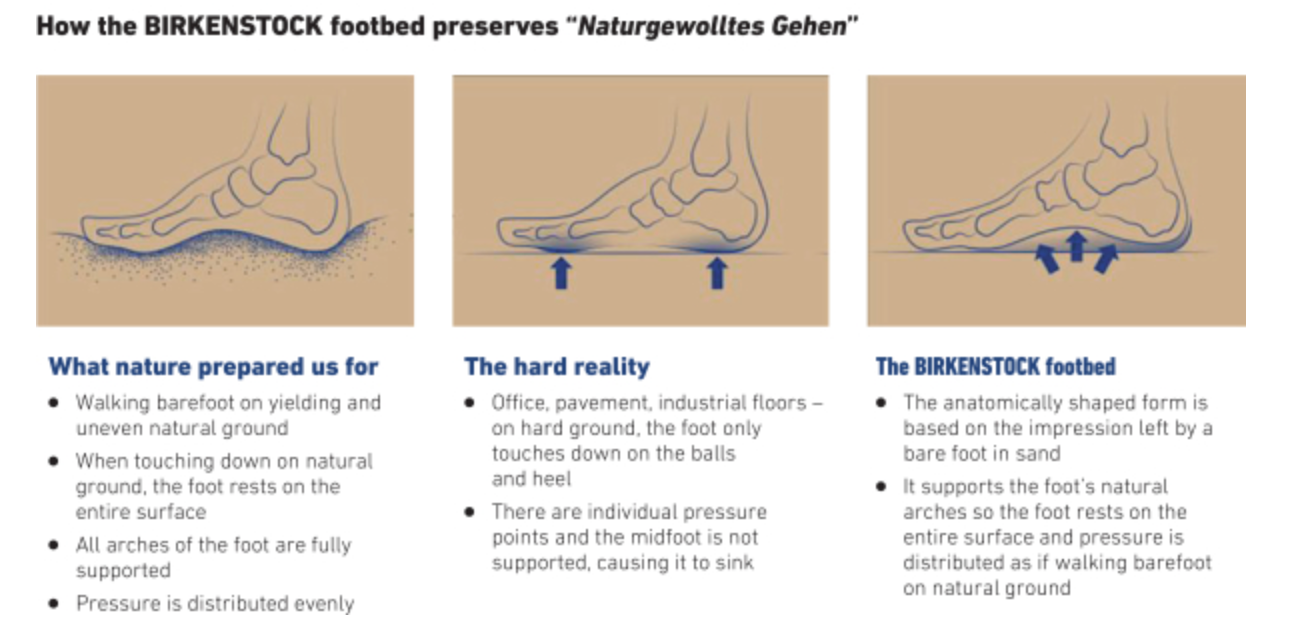
Original BIRKENSTOCK Footbed
The Original BIRKENSTOCK footbed is comprised of several distinctive components:
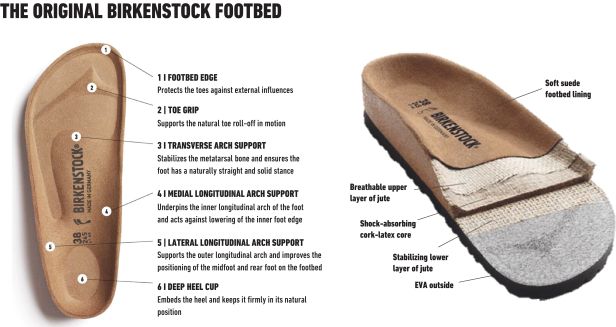
How Big is Birkenstock
Birkenstock has more than 5,000 people working for them wordlwide. Over 95% of the products are made in Germany.
Since 2013, 2013, the Company transformed its business from a family-owned, production-oriented company into a global, professionally managed enterprise committed to growing the brand and grew revenues at a 20% CAGR from fiscal 2014 to fiscal 2022.
According to its F-1 filing, Birkenstock’s fiscal 2022 revenue totaled €1.2428 billion ($1.34 billion) — a 70% increase from the €727.9 million ($782.46 million) in revenue it made in the 2020 fiscal year.
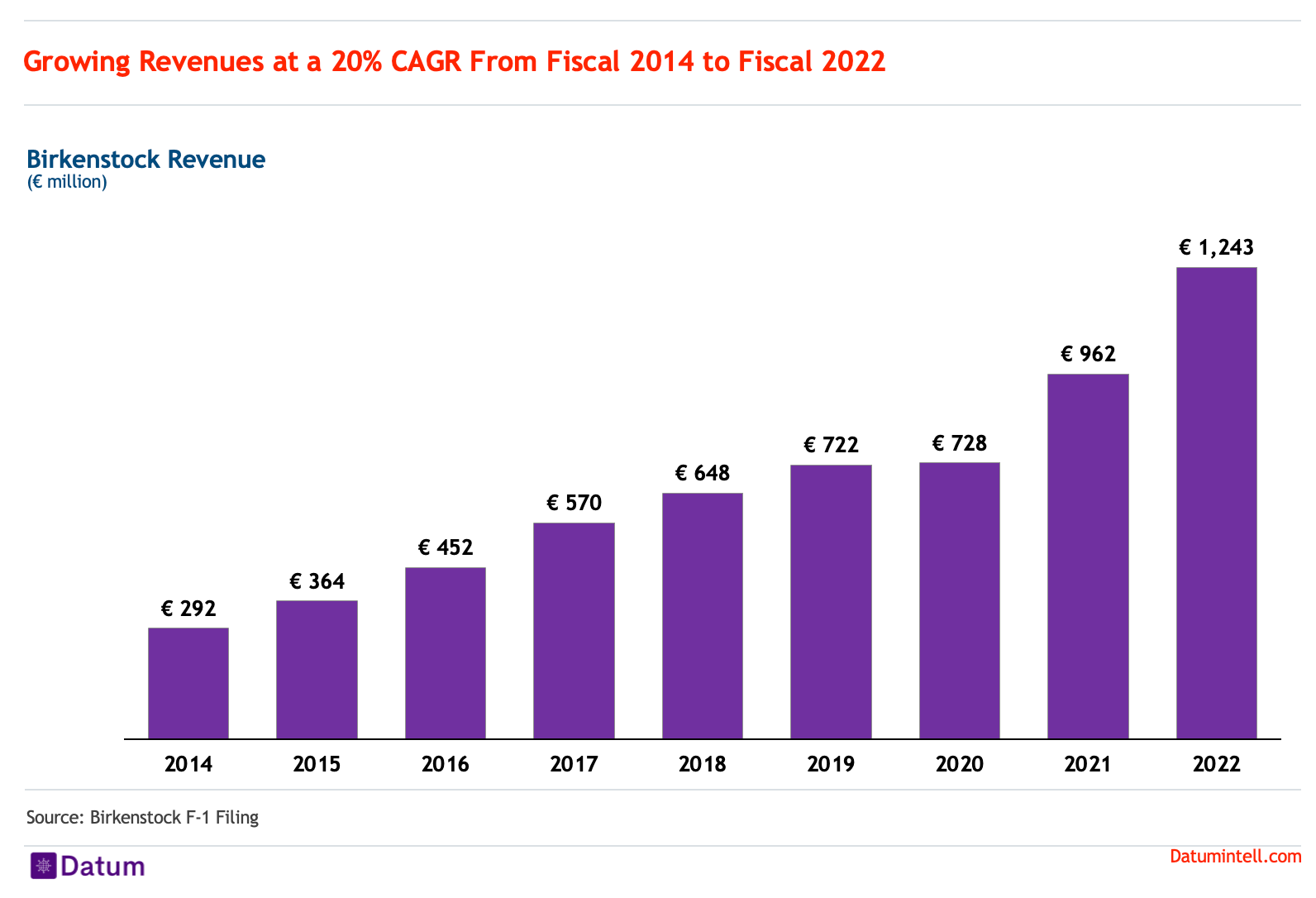
Top five silhouettes collectively generated nearly 76% of annual revenues in fiscal 2022.

Americas key Market. More than half — 54% — of the company’s customers are in the Americas with Europe accounting for 36%, followed by Asia-Pacific, Middle East and Africa region.
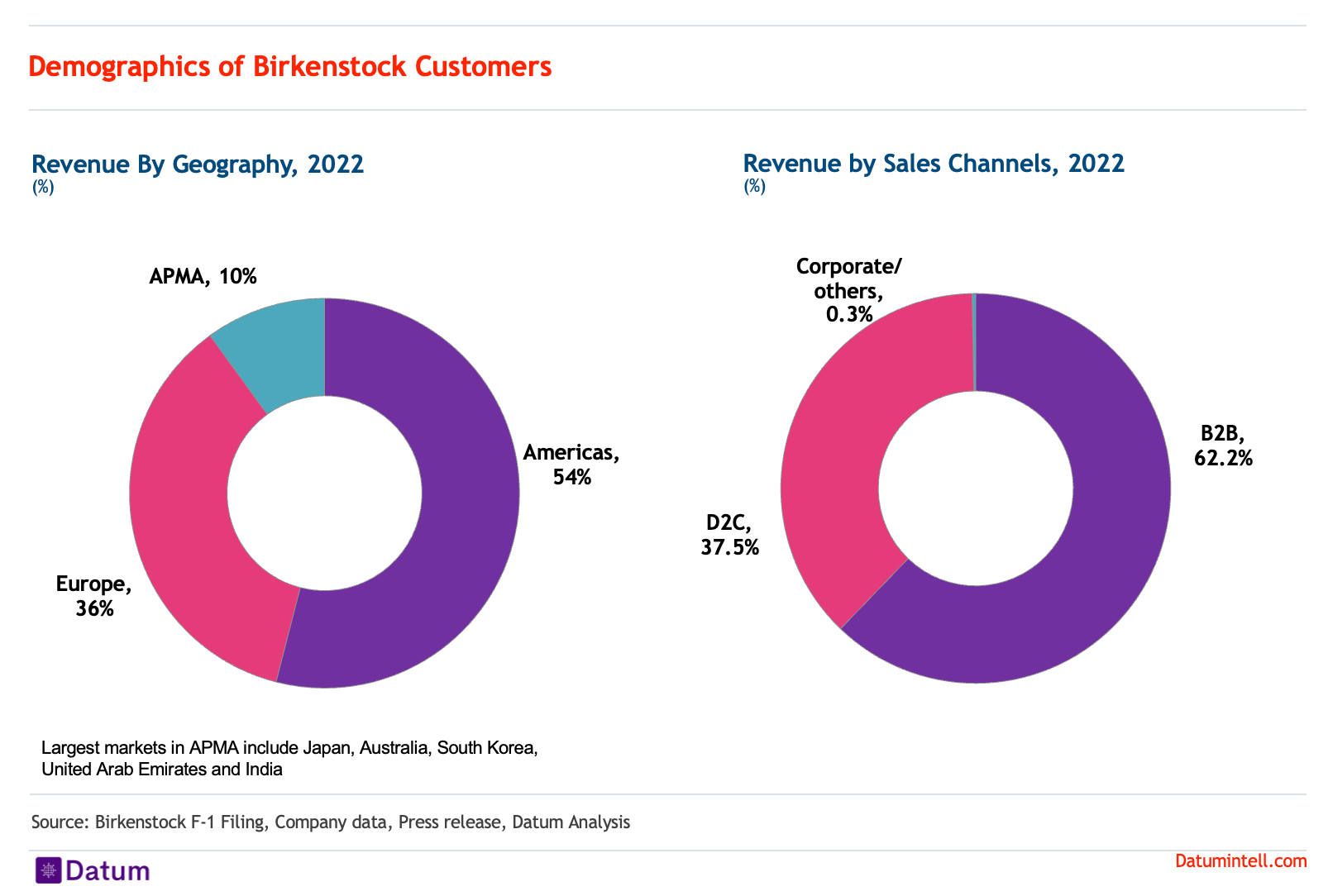
Unparalleled Consumer Engagement and Loyalty
What truly sets Birkenstock apart from its competitors is the brand's loyal and enthusiastic fan base. Birkenstock customers have praised the brand for its unparalleled comfort, style, and durability.
According to the Consumer Survey, the average BIRKENSTOCK consumer in the U.S. owns 3.6 pairs, reflecting the enthusiasm with which consumers engage with the brand. In addition, 86% of recent BIRKENSTOCK purchasers indicated a desire to purchase again.
Women make up 72% of Birkenstock customers. Though Birkenstock's customer base skews female, with 72% of customers being women, it's clear that the brand has strong appeal across all genders, generations, and age groups. Millennials lead the pack with 31% of sales, followed closely by Baby Boomers (30%) and Gen X (27%). While Gen Z (12%) may not be as large a part of the customer base, they are a key demographic for the future.
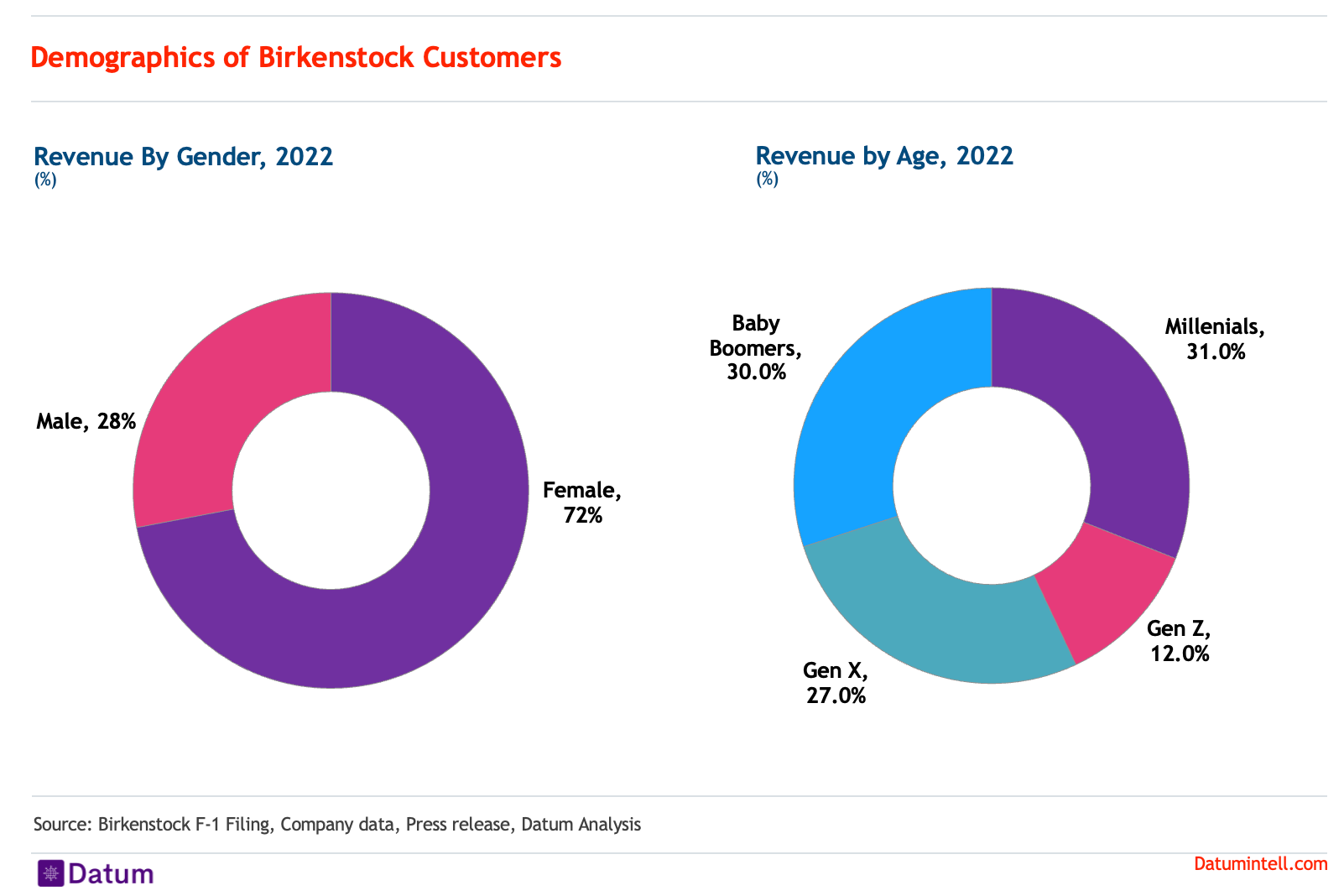
Balanced Shift Towards DTC. As part of the strategy to increase direct-to-consumer (DTC) penetration, DTC revenues grew at a compound annual growth rate (CAGR) of 42% between 2018 and 2022. This has been a successful and lucrative strategy for the company. Share of DTC channel increased from 18% in 2018 to 38% in 2022.
Since 2016, we have invested significantly in our online platform to support the penetration of our DTC channel, establishing our own e-commerce sites in more than 30 countries with ongoing expansion into new markets. In fiscal 2022, e-commerce represented 89% of our DTC channel. - Birkenstock F-1 Filing
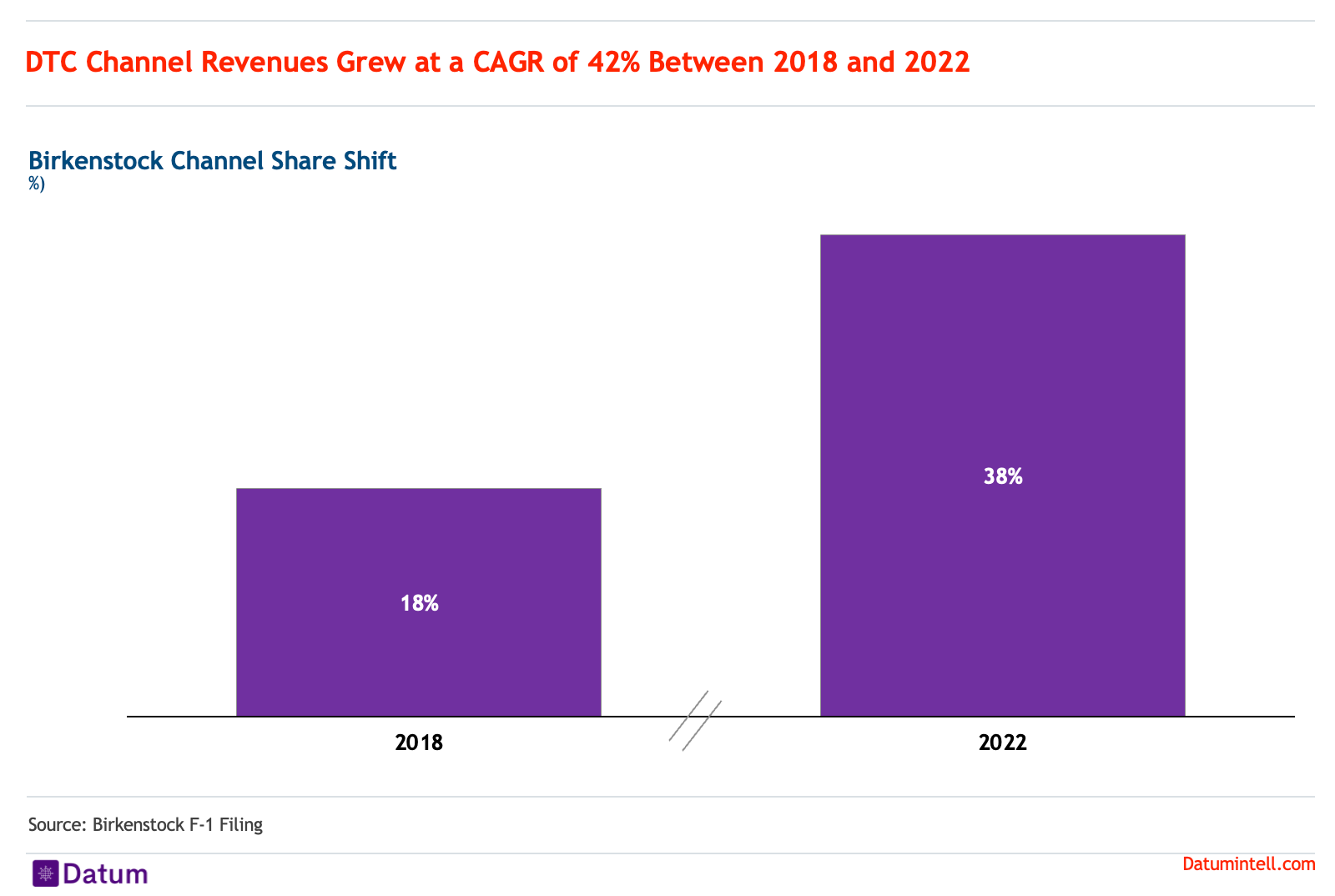
Efficient Demand Creation.
According to the Consumer Survey, nearly 90% of BIRKENSTOCK buyers come through unpaid channels. The top three sources of awareness being:
- Heard about it from a friend
- Saw someone wearing it and
- Growing up with it
How Big is Birkenstock in India
Birkenstock, the renowned German footwear brand, has made significant inroads into the Indian market in recent years. Birkenstock first entered the Indian market at the end of 2019 with an e-commerce store dedicated to the country and opened its first store in Jan 2020 in New Delhi International Airport. As of 2022, Birkenstock operates 25 stores across major Indian cities like Delhi, Mumbai, and Bengaluru, and its e-commerce store has experienced robust growth. The prices starts from INR 4,999 but it is one of the fastest growing brand in India. Revenue during the fiscal year that concluded in March 2022 for Birkenstock India was 56 crore, a 112% increase over the fiscal year that ended in March 2021.
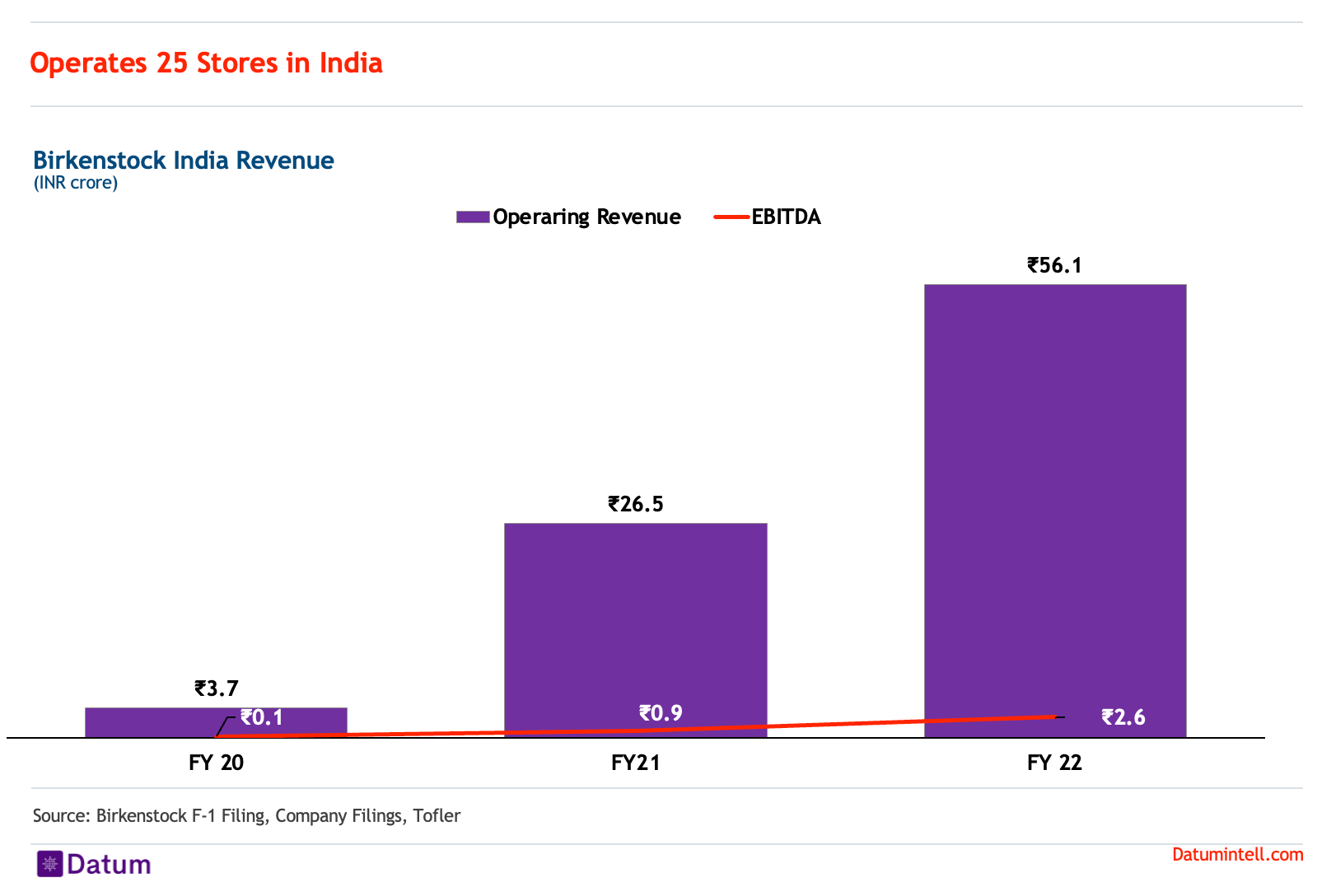
As Indian consumers become more affluent, they will be willing to spend more on quality footwear like Birkenstock. Additionally, the brand's unique design and comfortable fit also set it apart from other footwear brands in the Indian market.
If you're looking for high-quality, comfortable footwear, Birkenstock stores are definitely worth a visit.

